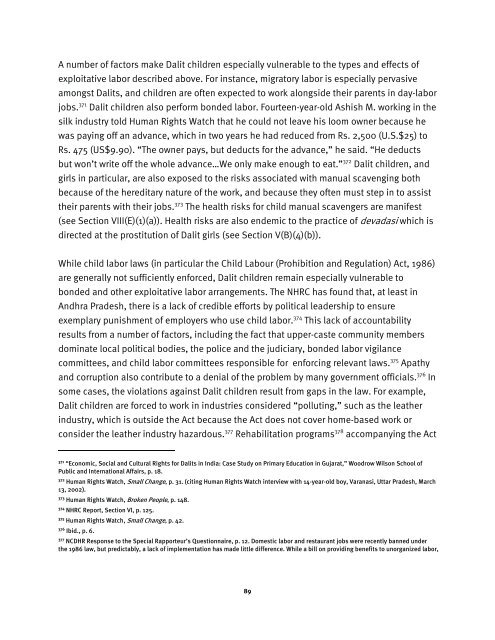Caste Discrimination against India's âUntouchablesâ - Human Rights ...
Caste Discrimination against India's âUntouchablesâ - Human Rights ...
Caste Discrimination against India's âUntouchablesâ - Human Rights ...
You also want an ePaper? Increase the reach of your titles
YUMPU automatically turns print PDFs into web optimized ePapers that Google loves.
A number of factors make Dalit children especially vulnerable to the types and effects of<br />
exploitative labor described above. For instance, migratory labor is especially pervasive<br />
amongst Dalits, and children are often expected to work alongside their parents in day-labor<br />
jobs. 371 Dalit children also perform bonded labor. Fourteen-year-old Ashish M. working in the<br />
silk industry told <strong>Human</strong> <strong>Rights</strong> Watch that he could not leave his loom owner because he<br />
was paying off an advance, which in two years he had reduced from Rs. 2,500 (U.S.$25) to<br />
Rs. 475 (US$9.90). “The owner pays, but deducts for the advance,” he said. “He deducts<br />
but won’t write off the whole advance…We only make enough to eat.” 372 Dalit children, and<br />
girls in particular, are also exposed to the risks associated with manual scavenging both<br />
because of the hereditary nature of the work, and because they often must step in to assist<br />
their parents with their jobs. 373 The health risks for child manual scavengers are manifest<br />
(see Section VIII(E)(1)(a)). Health risks are also endemic to the practice of devadasi which is<br />
directed at the prostitution of Dalit girls (see Section V(B)(4)(b)).<br />
While child labor laws (in particular the Child Labour (Prohibition and Regulation) Act, 1986)<br />
are generally not sufficiently enforced, Dalit children remain especially vulnerable to<br />
bonded and other exploitative labor arrangements. The NHRC has found that, at least in<br />
Andhra Pradesh, there is a lack of credible efforts by political leadership to ensure<br />
exemplary punishment of employers who use child labor. 374 This lack of accountability<br />
results from a number of factors, including the fact that upper-caste community members<br />
dominate local political bodies, the police and the judiciary, bonded labor vigilance<br />
committees, and child labor committees responsible for enforcing relevant laws. 375 Apathy<br />
and corruption also contribute to a denial of the problem by many government officials. 376 In<br />
some cases, the violations <strong>against</strong> Dalit children result from gaps in the law. For example,<br />
Dalit children are forced to work in industries considered “polluting,” such as the leather<br />
industry, which is outside the Act because the Act does not cover home-based work or<br />
consider the leather industry hazardous. 377 Rehabilitation programs 378 accompanying the Act<br />
371<br />
“Economic, Social and Cultural <strong>Rights</strong> for Dalits in India: Case Study on Primary Education in Gujarat,” Woodrow Wilson School of<br />
Public and International Affairs, p. 18.<br />
372<br />
<strong>Human</strong> <strong>Rights</strong> Watch, Small Change, p. 31. (citing <strong>Human</strong> <strong>Rights</strong> Watch interview with 14-year-old boy, Varanasi, Uttar Pradesh, March<br />
13, 2002).<br />
373<br />
<strong>Human</strong> <strong>Rights</strong> Watch, Broken People, p. 148.<br />
374<br />
NHRC Report, Section VI, p. 125.<br />
375<br />
<strong>Human</strong> <strong>Rights</strong> Watch, Small Change, p. 42.<br />
376<br />
Ibid., p. 6.<br />
377<br />
NCDHR Response to the Special Rapporteur’s Questionnaire, p. 12. Domestic labor and restaurant jobs were recently banned under<br />
the 1986 law, but predictably, a lack of implementation has made little difference. While a bill on providing benefits to unorganized labor,<br />
89

















